1.Concept of Marugoto
Marugoto Japanese Language and Culture (Marugoto) is a set of learning materials created with the idea of putting into practice Japanese language education that promotes mutual understanding. This is done by cultivating in learners an ability to achieve goals through language communication and an attitude where they understand and respect both their own and other cultures. The title Marugoto, which means in its entirety, contains the message that the writers would like to transmit: Japanese language and culture in its entirety, real communication between people in its entirety, the lifestyle and culture that underpins this communication in its entirety.
2.Basic thinking behind Marugoto
Marugoto is based on the language education framework known as the JF Standard for Japanese- Language Education (JFS), which was created with the idea of putting into practice Japanese language education that promotes mutual understanding. Marugoto has the following features:Can-do objectives
The aim of Marugoto is for learners to be able to take part in communication using Japanese in a variety of real-life situations. For this reason, learning objectives are set in the form of Can-dos that describe what learners will be able to do using Japanese. Furthermore, the language structures that will be studied are chosen based on what is needed to attain the Can-dos.
Marugoto’s levels correspond with the six stages of the JFS (A1, A2, B1, B2, C1 and C2). The textbooks that are currently available are Starter (A1), Elementary 1 and 2 (A2), Pre-Intermediate (A2/B1), and Intermediate 1 and 2 (B1). Because the six levels of the JFS follow the same level system as the CEFR* it is easy to compare ability in the Japanese language to ability in other languages.
* abbreviation of Common European Framework of Reference for Language: Learning, teaching, and assessment
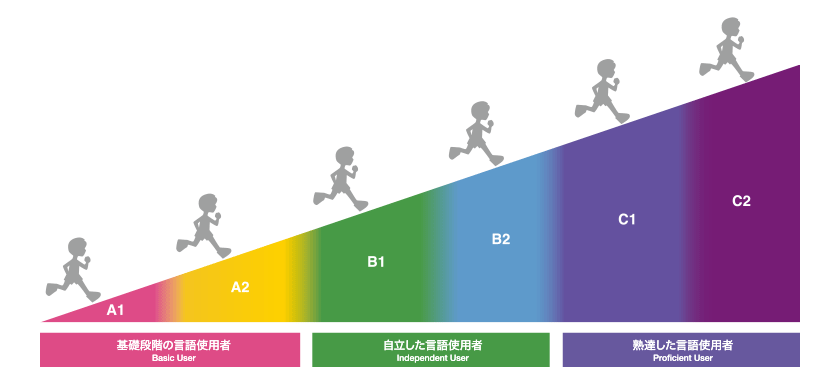
- A1
- A2
- B1
- B2
- C1
- C2
- - Can understand and use familiar everyday expressions and very basic phrases aimed at the satisfaction of needs of a concrete type.
- Can introduce him/herself and others and can ask and answer questions about personal details such as where he/she lives, people he/she knows and things he/she has.
- Can interact in a simple way provided the other person talks slowly and clearly and is prepared to help. - - Can understand sentences and frequently used expressions related to areas of most immediate relevance (e.g. very basic personal and family information, shopping, local geography, employment).
- Can communicate in simple and routine tasks requiring a simple and direct exchange of information on familiar and routine matters.
- Can describe in simple terms aspects of his/her background, immediate environment and matters in areas of immediate need. - - Can understand the main points of clear standard input on familiar matters regularly encountered in work, school, leisure, etc.
- Can deal with most situations likely to arise whilst travelling in an area where the language is spoken. Can produce simple connected text on topics which are familiar or of personal interest.
- Can describe experiences and events, dreams, hopes & ambitions and briefly give reasons and explanations for opinions and plans. - - Can understand the main ideas of complex text on both concrete and abstract topics, including technical discussions in his/her field of specialisation.
- Can interact with a degree of fluency and spontaneity that makes regular interaction with native speakers quite possible without strain for either party.
- Can produce clear, detailed text on a wide range of subjects and explain a viewpoint on a topical issue giving the advantages and disadvantages of various options. - - Can understand a wide range of demanding, longer texts, and recognise implicit meaning.
- Can express him/herself fluently and spontaneously without much obvious searching for expressions.
- Can use language flexibly and effectively for social, academic and professional purposes.
- Can produce clear, well-structured, detailed text on complex subjects, showing controlled use of organisational patterns, connectors and cohesive devices. - - Can understand with ease virtually everything heard or read.
- Can summarise information from different spoken and written sources, reconstructing arguments and accounts in a coherent presentation.
- Can express him/herself spontaneously, very fluently and precisely, differentiating finer shades of meaning even in more complex situations.
Topics
A variety of topics that take into account learners’ interests are featured in Marugoto. For each level topics were chosen that will motivate learners to collect and exchange information. These topics relate to the 15 topics of the JFS, and by studying the same topics in a spiral as learners change levels, the things they can communicate about will increase naturally.
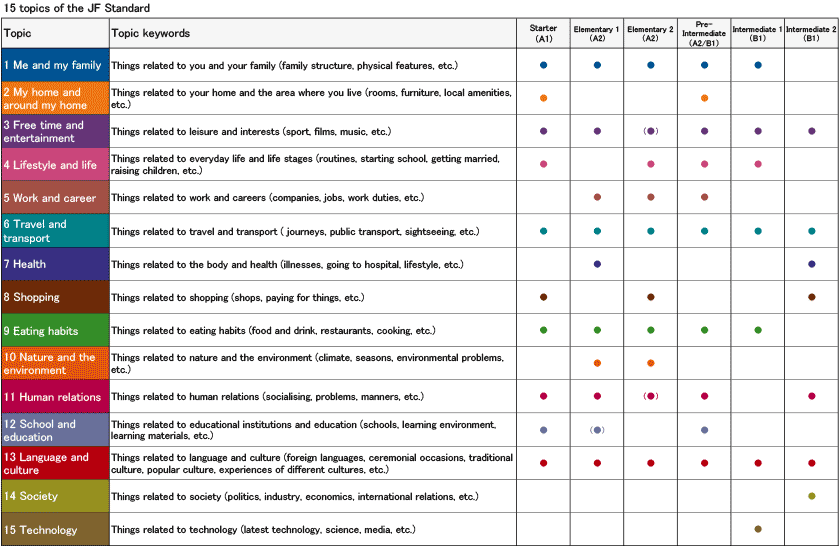
※Table contrasting the topics covered in each Marugoto book Starter (A1)-Intermediate (B1)(42KB)
Understanding different cultures
In the JFS, as well as the ability to attain Can-dos, an emphasis is placed on the ability to understand foreign cultures. The contents of the material, tasks, etc. were devised so that learners are encouraged to take an interest in different cultures, and are able to think about the differences between these cultures and their own cultures, and the reasons for these. In addition, learners will be able to develop an attitude where they respect each other’s cultures.
Managing your own learning
In Marugoto a focus is placed on learners making independent progress in their study of Japanese language and culture according to their individual interests. For this reason, Marugoto incorporates self assessment using Can-do Checks and the creation of a Portfolio proposed by the JFS for reflection and recording of learning processes.
3.Contents and special features of each level of the textbook
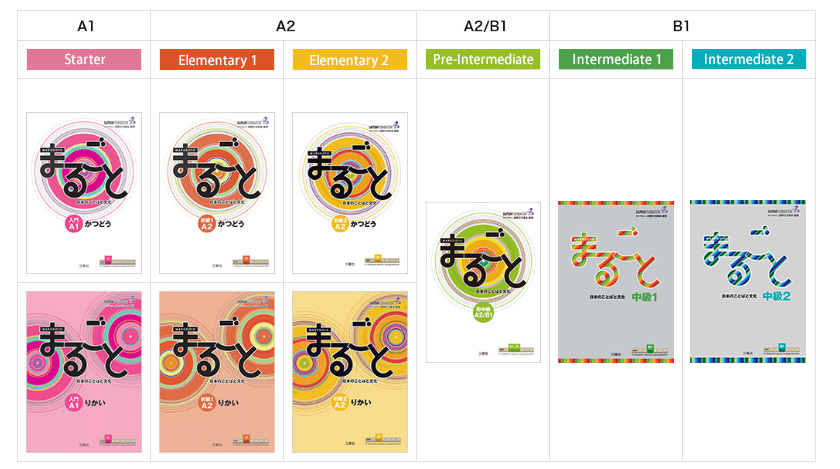
There are two types of course book for Starter (A1) and Elementary 1 and 2 (A2): Rikai and Katsudoo. They are each made with different learning objectives and approaches, but they share the topics that form the overall framework of the syllabus and the situations in which language is used, and they are both designed to complement each other. For this reason, in order to meet the various needs of learners at the beginner stage, Rikai and Katsudoo can be used either together as one course, or separately.
① Starter (A1)
Starter (A1) Katsudoo (Coursebook for communicative language activities)
In total 9 topics and 18 lessons.
Estimated classroom time: 30-40 hours (90-120 minutes/lesson)
Marugoto Starter (A1) Katsudoo is a course that aims to help learners become able to take part in communicative language activities. There are 50 Can-do objectives that centre on interaction in Japanese. Conversations that aim to put the Can-dos into practice are set in situations that are natural to overseas students and that can be achieved without requiring complex sentences. Can-dos that employ visual information such as notes and maps are a special feature of the Starter level (A1).
The order of classroom activities proceeds from learners listening to a recording of a conversation fully, noticing by themselves the important expressions used in the conversation, before going on to speaking practice. This is done to reflect second language acquisition processes. A focus is placed on becoming accustomed to listening input, and because text is written in kana and the Roman alphabet, burden of learning and reading Japanese characters are reduced. The aim of the study related to Japanese characters is for learners to become able to read 60% of all the words written in hiragana and katakana . So that Japanese language learning that focuses on listening input can take place during limited class time, there is no particular focus on being able to write characters.
Vocabulary study is arranged so that learners learn words and phrases that they need in order to give information about themselves, rather than learners remembering every word and phrase in the book. To find the words and phrases that they need, learners should use the Word Book.
On the Lifestyle and Culture page learners can look at photographs, learn about Japanese people’s everyday lives, and exchange impressions and opinions. As much as possible, Starter level (A1) deals with the type of content that can be understood through looking at photographs, such as shops and things you can see in the street, souvenirs and sightseeing spots, etc.. It is expected that learners will use their first language in order to be able to talk freely about what they think.
Starter (A1) Rikai (Coursebook for communicative language competences)
In total 9 topics and 18 lessons.
Estimated classroom time: 40 hours (120 minutes/lesson)
The Marugoto Starter level (A1) Rikai course centres on study of language features that support communication (Japanese characters, vocabulary, grammar, sentence structure, etc.). At the Starter level the most basic sentence structures are studied (sentences with nouns, sentences with adjectives, present and past forms of sentences with verbs, etc.). A big difference between Marugoto and a textbook with a structural syllabus is that the learning points, such as sentence patterns, were chosen based on language activities. The two books are linked in that the learning points in Rikai have been extracted from the model conversations for the Can-do objectives in Katsudoo. Because both the structure and meaning of the learning points at Starter level (A1) are simple, it is possible for teachers to keep explanations to a minimum. All sentences used in the practice exercises are related to the context of the featured topic. Using audio recordings to check answers makes learning more effective. 65 words written in kanji appear in Rikai and their reading is learned. The learning objectives related to Japanese characters are being able to read the 65 words written in kanji, and being able to read 80% and write 60% of all words written in hiragana and katakana. In the same way as in Katsudoo, in Rikai the Word Book is used so that vocabulary can be practised efficiently and effectively.
② Elementary 1 and 2 (A2)
Elementary 1 and 2(A2) Katsudoo (Coursebook for communicative language activities)
In total 9 topics and 18 lessons.
Estimated classroom time: 40-60 hours (120-180 minutes/lesson)
Marugoto Elementary 1 and 2 (A2) Katsudoo are courses that, in the same way as the Starter level (A1), aim at helping learners become able to take part in communicative language activities. There are 53 and 49 Can-do objectives respectively, centered on interactive communication in Japanese. The Can-do conversations are a little longer than those at Starter level (A1), and include more complex conversations. There are also Can-dos that involve extended speaking in front of others, such as presentations and speeches at events. In order to attain these Can-dos a range of elementary sentence patterns used naturally appear in the materials. At Elementary 1 and 2 (A2), classroom activities, in the same way as at Starter level (A1), focus on learners noticing by themselves the important expressions used in audio recordings of conversations that they listen to fully before doing speaking practice. At Starter (A1) level fixed expressions are very common, but at Elementary 1 and 2 level (A2) expressions that are structurally a little complex increase, such as expressions that involve conjugation of parts of speech, modification of nouns, etc. Because of this, the section Discover was devised in order to guide students on how to notice correctly.
The aim of the study related to Japanese characters is to become able to read 100% of katakana and hiragana by the end of Elementary 2 (A2). In Lifestyle and Culture there is an increase in the number of questions that turn to aspects of Japanese society in learners’ immediate environments, such as the roles of men and women, volunteer activities, and the generation gap.
Elementary 1 and 2 (A2) Rikai (Coursebook for communicative language competences)
In total 9 topics and 18 lessons.
Estimated classroom time: 40-60 hours (120-180 minutes/lesson)
In the same way as the Starter level (A1), the learning in Marugoto Elementary 1 and 2 (A2) Rikai course centres on the elements of language that support communication (vocabulary, grammar, sentence patterns, etc.). Learning points are chosen based on the Can-do objective model-conversations in Katsudoo. The majority of so-called elementary level sentence patterns make up the learning points, but in the case of sentence patterns that have multiple meanings or functions, only the function needed in the Can-do conversation is featured and then practised. In addition, the same sentence pattern will appear in a different topic and be studied again.
The learning objective for Japanese characters at Elementary 1 level (A2) is to be able to read 100% and write 80% of hiragana and katakana. At Elementary 2 level (A2) the learning objective is to be able to write 100% of hiragana and katakana. For kanji, the learning objective is to be able to read all newly introduced words written in kanji (156 in Elementary 1 (A2) and 170 in Elementary 2 (A2)).
Elementary 1 and 2 (A2) contains a Words and Culture section. This is to encourage the study of the understanding of cultural differences through the use of words. Learners try to think not just about what should be said in different situations, but why it is said, the speaker’s intentions and the response of the listener.
③ Pre-Intermediate (A2/B1)
In total 9 topics.
Estimated classroom time: 60-80 hours (6-8 hours/topic)
The Marugoto Pre-Intermediate (A2/B1) course aims to review and apply what was studied from Starter (A1) to Elementary 2 level (A2), and prepare learners to proceed to the next level. For this reason it consists of both A2 and B1 level Can-dos. At Pre-Intermediate level (A2/B1) there are a total of 44 Can-do objectives. The aim of the first half of each topic is interaction in Japanese. Learners listen to and practise a variety of conversations that are longer than those used up to Elementary 2 level (A2). In addition, the language expressions featured in the Discovery sections are intended to allow review and application of those studied up to the Elementary 2 level (A2) (language forms).
The second half of each topic is centered on reading activities. New learning points are extracted from the reading texts and practised. After that, learners read another text with the same theme.
At Pre-Intermediate level (A2/B1) learners express their feelings and consider listeners’ points of view, and topics start to cover a few aspects of people’s inner lives. Learners can enjoy putting to use the Japanese learning they have accumulated up to Elementary 2 (A2). In addition, in the same way as in Elementary 1 and 2 (A2) Rikai, in Pre-Intermediate (A2/B1) there is a Language and Culture section. Learners will be able to think further about how to use words that make communication smoother.
④ Intermediate 1 and 2 (B1)
In total 9 topics for each.
Estimated classroom time: About 80-120 hours (8-13 hours/topic)
The aim of Marugoto Intermediate 1 and 2 (B1) is for learners to reach the level of Independent Language User where they can have a coherent conversation in Japanese, understand the main points of texts about familiar topics, and deal with a range of things by themselves when they go to Japan.
Each topic is divided by skill into the 5 parts of Listen and Understand, Have a Conversation, Speak at Length, Read and Understand and Write, and in each part there are Can-dos that serve as learning objectives. At intermediate level learners’ learning contexts and needs are varied, so it is possible to extract the parts of the course book needed and use these in a lesson, rather than only studying the course book in order.
The Can-dos that serve as learning objectives involve accomplishment of tasks in situations that could actually exist overseas. The aim is concrete activities that take place in situations where Japanese is actually used, such as talking about topics that interest you in a conversation with a Japanese person, reading and more or less understanding the contents of a website written in Japanese, and posting on a social networking site in Japanese. Unlike many previous intermediate teaching materials, increasing knowledge of difficult vocabulary and grammar and intensive reading of long texts is not an objective in itself. The objective is for learners to increase the things they can do in Japanese.
In order to be able to take part in communication in Japanese in the real world, it is necessary to cultivate the ability to tackle authentic Japanese. For this reason, at Intermediate level (B1) learning takes place using materials that are as realistic and close to authentic as possible. Many difficult vocabulary, kanji, and colloquial expressions appear, but by cultivating the ability to accomplish tasks even when there are things that are not understood, the aim is to improve the ability to actually use Japanese outside the classroom. In particular, in order for communication to take place even within the range of Japanese that an intermediate learner is limited to, the course book features a lot of practice of strategies, such as guessing meaning, and paraphrasing.
A wide variety of contents are featured in each topic, from things related to traditional Japanese culture, such as hot springs, martial arts, kabuki and ninjas, to things dealing with contemporary Japanese society and culture, such as manga, J-Pop and online shopping. In addition, a lot of contemporary material is used, such as ONE PIECE, KOBUKURO and OOEDO-ONSEN MONOGATARI. Learners can learn Japanese that they can actually use while having fun studying topics they are interested in.
4. Development of Marugoto
In 2010, the project to develop Marugoto, was started in order to put the JFS into the form of a coursebook as a concrete example of the application of the JFS. Lecturers at the Japanese-Language Institute, Urawa formed a team and developed the coursebook following a series of discussions about how to integrate the JFS framework into a coursebook, including what the features of each level are, what kind of course design is effective for the goal of accomplishing tasks (Can-dos), what competence in understanding other cultures means, and how learners’ ability should be assessed.
Marugoto is a set of teaching materials based on overseas teaching practice. A trial version of each level was made, and after the materials were actually used in Japanese language lessons overseas (JF Language Course), revisions were made before the materials were released commercially. JF Language Courses are general Japanese language lessons for adults that the Japan Foundation offers in 28 locations across the world (as of October 2020). A process of trial and error, while collecting feedback from the classroom, was carried out into the kinds of situations in which overseas learners use Japanese, the kinds of topics and materials that are suitable, and most importantly the best way to create materials that both learners and teachers enjoy using. In JF Language Course today lessons are offered that use Marugoto, which was completed as a result of this process, and with the cooperation of JF Language Course in each area where JF Language Course are offered, support materials are being created in a number of languages.
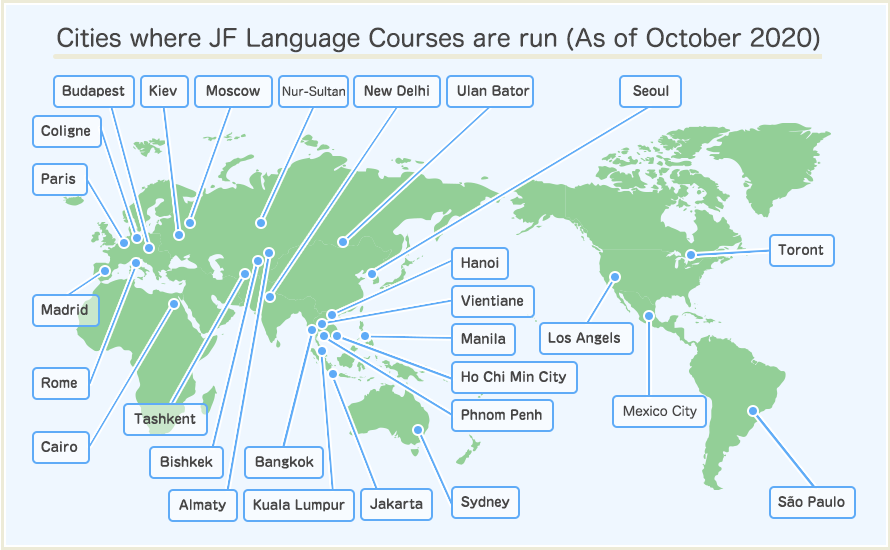
Chronological table of Marugoto project
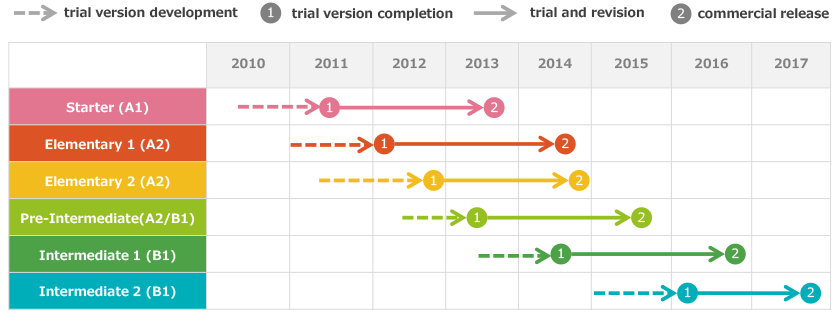
Writers
Starter A1: Hiromi Kijima, Tomoyo Shibahara, Naomi Hatta
Elementary 1 A2: Hiromi Kijima, Tomoyo Shibahara, Naomi Hatta, Hisae Imai, Naoyuki Kitani
Elementary 2 A2: Hiromi Kijima, Tomoyo Shibahara, Naomi Hatta, Naoyuki Kitani, Makoto Netsu
Pre-Intermediate A2/B1: Hiromi Kijima, Tomoyo Shibahara, Naomi Hatta
Intermediate 1 B1: Kazuhiro Isomura, Kaoru Fujinaga, Yoshiko Kubota, Yukiko Ito
Intermediate 2 B1: Kazuhiro Isomura, Kaoru Fujinaga, Yukiko Ito, Yoshiko Kubota
Production cooperators
Yoko Uchida, Kyoko Suzuki, Shiho Matsuno
Andrew Drought, James Stuart-Jones
